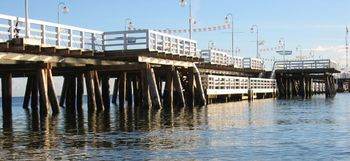Piers and trestles
This article gives a short introduction in the application of piers and trestles.
Introduction
Piers are rather long structures with a horizontal deck on series of piles extending perpendicular to the coast into the sea. Piers and trestles are constructed to serve as a landing place for vessels, as a recreation facility, as a measuring facility for coastal processes or as a part of sand by-pass facility. Figure 1 shows an example of a pier.
Possible impact on coastal processes
The supporting piles of these structures may have an impact on coastal processes. Especially if the number of piles is rather large and/or with large diameters of the piles, obliquely arriving waves will cause an area with reduced wave heights in the lee of the structure. The sediment transports will be reduced as well; spots with some accretion might occur (in general at both sides since waves will approach from both sides). Especially for measuring piers this might yield a-typical measuring conditions.
See also
References
Please note that others may also have edited the contents of this article.
|
